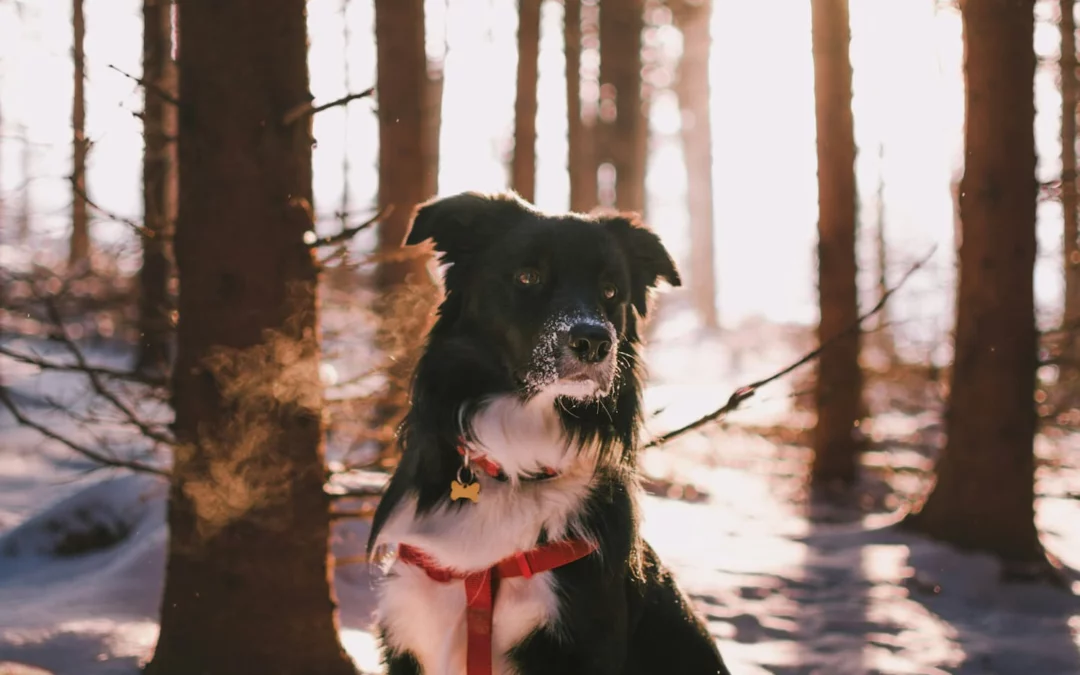Minnesota winters are no joke, and while we’re bundling up in our warmest coats, it’s important to remember that our pets need protection from the cold too. Winter weather in Shoreview can pose unique challenges for pets, including risks like frostbite, paw injuries from ice, and even hypothermia. Thankfully, with a little preparation and care, you can ensure your furry friends stay safe and cozy all season long.
Here are essential tips to help keep your pet healthy and happy during the chilly months.
Keep Your Pets Warm and Cozy
Pets, even those with fur, are vulnerable to extreme cold. Short-haired and small breeds often need an extra layer of warmth, like a sweater or jacket, to help regulate their body temperature during walks. Indoors, ensure your pet has a warm sleeping area away from drafts and provide soft bedding to retain heat. Limit outdoor time to prevent frostbite and hypothermia, especially during severe weather.
Why Keep Your Pets Indoors During Extreme Cold
Minnesota winters can be dangerously cold for pets. Prolonged exposure to freezing temperatures increases the risk of frostbite and hypothermia, even for cold-tolerant breeds. Keeping pets indoors during harsh weather is the safest choice. If outdoor time is necessary, keep it brief to protect their health.
Tips for Short-Haired Breeds or Pets Needing Extra Warmth
Short-haired and small breeds, like Chihuahuas and Sphynx cats, often need added protection from the cold. Pet sweaters or jackets made from insulating materials like fleece or wool are ideal for maintaining body heat. Heated pet beds or blankets are excellent alternatives for pets who dislike clothing, offering comfort and warmth, especially for older or arthritic pets.
Creating a Warm, Draft-Free Sleeping Space for Pets
Provide your pet with a cozy, warm sleeping area away from drafts and cold floors. Use elevated pet beds or thick, insulating bedding materials like fleece. For small animals like rabbits or guinea pigs, add extra bedding such as hay and ensure enclosures are insulated but not overheated. Regularly check your pet’s ears, paws, and nose for coolness to ensure they’re warm and comfortable.
Protect Their Paws from Snow and Ice
Dangers of Ice, Snow, and Salt to Paw Pads
Winter elements such as ice, snow, and sidewalk salt can harm your pet’s paw pads. Ice can cut or scrape the sensitive pads, compacted snow can cause frostbite or discomfort, and salt can irritate or burn the skin. Pets licking their paws after exposure to salt may ingest harmful chemicals, leading to digestive upset or toxicity. Protecting your pet’s paws minimizes these risks.
Benefits of Using Booties or Paw Balms
Booties shield your pet’s paws from ice, salt, and snow while improving traction on slippery surfaces. Ensure the booties are weatherproof, secure, and comfortable. For pets that dislike wearing booties, paw balms create a protective barrier, preventing dryness and cracking while also moisturizing the pads. Apply paw balm before walks and reapply as needed.
Steps for Cleaning and Drying Paws After Walks to Prevent Irritation
- Inspect for Debris: Check for snow, ice, or salt between the toes to avoid irritation or frostbite.
- Wipe with a Damp Towel: Use a warm towel to remove harmful residues like road salt and ice melt.
- Dry Thoroughly: Dry paws with a soft towel to prevent cracks from moisture exposure.
- Check for Injuries: Look for redness, cuts, or irritation, and treat minor issues with pet-safe balm.
- Moisturize if Necessary: Use a moisturizing balm for pets prone to dry or cracked pads.
By cleaning and caring for your pet’s paws after each walk, you can prevent discomfort, injuries, and long-term damage from winter conditions.
Avoid Winter Hazards
Risks of Antifreeze Poisoning and Safe Storage Tips
Antifreeze is highly toxic to pets due to its sweet taste and smell, which can attract them. Even small amounts can cause severe poisoning, leading to kidney failure or death. To prevent accidents:
- Store antifreeze securely in sealed containers out of reach.
- Clean up any spills immediately and thoroughly.
- Use pet-safe antifreeze with less toxic ingredients like propylene glycol.
If ingestion occurs, seek veterinary care immediately. Symptoms include vomiting, lethargy, loss of coordination, and excessive thirst.
Symptoms of Frostbite and Hypothermia
Frostbite and hypothermia are serious risks for pets exposed to freezing temperatures. Frostbite affects extremities such as ears, tails, and paws, showing signs like pale, cold skin, swelling, or blisters. Hypothermia occurs when body heat drops too low, with symptoms such as shivering, lethargy, weak breathing, and stiff muscles. If these conditions are suspected:
- Bring your pet indoors to a warm environment.
- Gradually warm them with blankets or towels (avoid direct heat sources).
- Contact a veterinarian immediately for proper care.
Safety Tips for Avoiding Frozen Ponds and Lakes
Frozen ponds and lakes can be deceptive and dangerous. Ice may appear solid but can easily crack, putting your pet at risk of falling into icy water. To prevent accidents:
- Always keep pets on a leash near frozen water bodies.
- Prevent pets from playing or wandering on the ice.
- Educate family members and pet sitters about these hazards.
If your pet falls into icy water, call emergency services rather than attempting a risky rescue. Post-rescue, warm your pet gradually and consult a veterinarian to address any hypothermia or shock concerns.
By understanding these hazards and taking preventive measures, you can keep your pet safe throughout the winter months.
Maintain Proper Nutrition and Hydration
Adjusting Food Intake Based on Activity Level and Metabolic Needs
Winter can alter your pet’s metabolism and energy needs. Active pets or those spending time outdoors may require extra calories to maintain body heat, while less active pets may need fewer calories to prevent weight gain. Regularly monitor your pet’s weight and consult your veterinarian to adjust their diet appropriately, especially for senior pets or those with medical conditions.
Ensuring Pets Have Access to Fresh, Unfrozen Water
Hydration is crucial year-round, but water can freeze in winter, making it inaccessible to pets. Check water bowls frequently to ensure they are fresh and unfrozen. Use heated or insulated bowls for outdoor pets and offer slightly warm water to encourage drinking in cold weather. Staying hydrated supports your pet’s overall health, digestion, and circulation.
Using Plastic Bowls to Prevent Pets’ Tongues from Sticking in the Cold
Metal bowls can pose a winter hazard, as pets’ tongues may stick to the freezing surface, causing injury. Switch to plastic, ceramic, or silicone bowls to avoid this risk. For outdoor pets, insulated or heated bowls are ideal to keep water drinkable and prevent freezing, ensuring pets stay hydrated during colder months.
Quick Checklist for Winter Pet Safety
Here’s a quick list to help you keep your pet safe this winter:
- Limit Outdoor Time: Keep outdoor trips short to avoid frostbite and hypothermia.
- Provide Extra Warmth: Use sweaters or jackets for short-haired pets and provide cozy, draft-free indoor bedding.
- Protect Paw Pads: Use booties or paw balm and clean paws after walks to prevent irritation or injury.
- Watch for Frostbite and Hypothermia: Look for signs like pale extremities or shivering; act quickly if symptoms appear.
- Avoid Frozen Water: Keep pets on a leash near ponds or lakes to prevent accidents on thin ice.
- Secure Antifreeze: Store antifreeze safely and use pet-safe versions to avoid poisoning.
- Monitor Food and Water: Provide fresh, unfrozen water and adjust food intake based on activity level.
- Avoid Leaving Pets Outdoors or in Cars: Extreme cold can be as dangerous as heat; bring pets inside.
- Care for Older Pets: Provide extra warmth and consult your vet about winter-specific needs for senior pets.
- Prepare a Winter Emergency Kit: Include blankets, towels, paw balm, and first-aid supplies for unexpected situations.
Following these steps will help keep your pet safe and comfortable during the winter months.
When to See a Veterinarian
Sometimes, even with the best precautions, pets can still experience winter-related health issues. If your pet shows signs of frostbite, hypothermia, or any other unusual symptoms, don’t wait—seek veterinary attention immediately. Our team at Minnesota Veterinary Hospital is here to help your pet through the winter months. We can provide guidance on cold-weather care, perform wellness exams, and treat any cold-related health concerns.
Additionally, if you’re looking for winter supplies like booties or paw balms, check out our online pharmacy for convenient shopping.
Keeping Pets Safe All Winter Long
Winter weather doesn’t have to be stressful for pet owners. By taking a few simple precautions, you can keep your pet warm, healthy, and safe during even the coldest days. Whether it’s bundling them up in cozy gear, protecting their paws from snow and ice, or scheduling a check-up with your veterinarian, every small step helps.
Have questions about your pet’s winter care? Contact Minnesota Veterinary Hospital at (651) 484-3331 today to schedule an appointment. Together, we’ll make sure your furry friend has a safe and happy winter!
Image Credit: Unsplash

